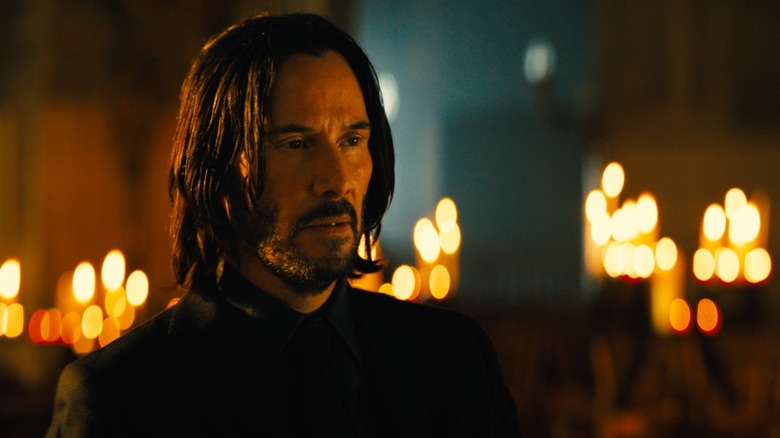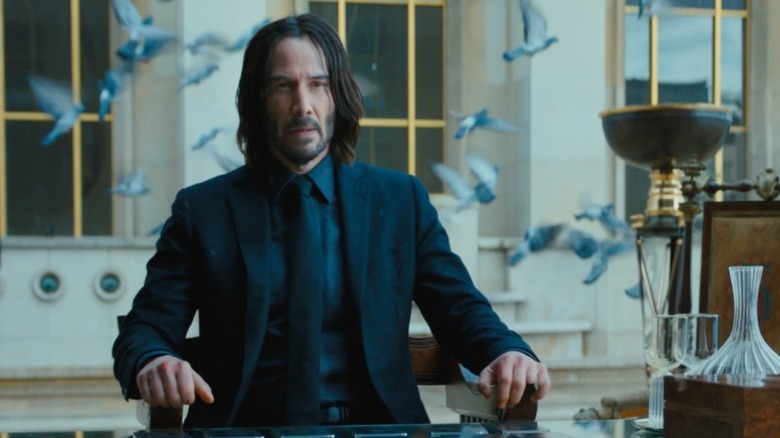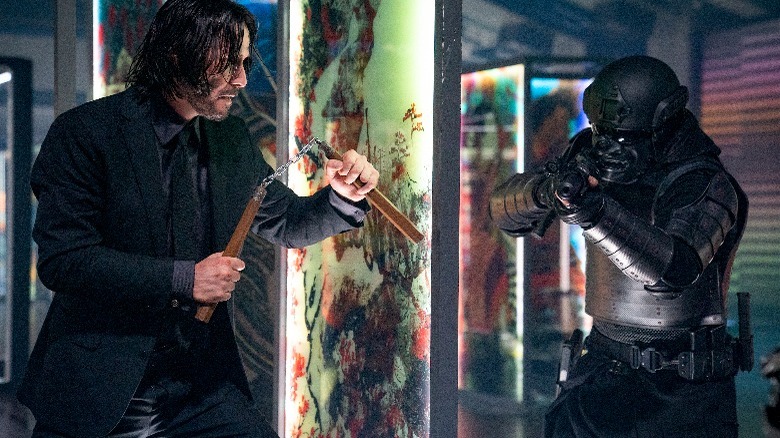John Wick: Chapter 4 Producer Says First Cut Was 'Rough And Boring In Parts'
An almost-mythical assassin ventures beyond the point of no return, now that he has nothing left to lose. As he nears the end of his long-winding, ultra-violent path to salvation, he beats up innumerable goons, faces off against crime bosses, and indiscriminately kills anyone standing in his way. Such is the scope and ambition of Chad Stahelski's "John Wick: Chapter 4," a nearly three hour long movie that's as fast and thrilling as action-driven films come. Not that longer movies, in general, are necessarily harder to sit through — after all, an eight-minute short could be tedious to watch, whereas a four-hour cut of a deftly-crafted saga might feel like a breeze. "John Wick: Chapter 4" is near-perfect in terms of the quality it delivers within its runtime, as things are allowed to develop at an appropriate pace without ever feeling rushed or hackneyed.
When fans of the franchise learned that the first, rough cut of "Chapter 4" was nearly three hours and 45 minutes long, they expected an even better version with high-intensity deleted action scenes to look forward to. A longer cut would mean more John Wick (Keanu Reeves), which is never a bad thing, and hopefully additional scenes that grant more meaning or context to the ones in the theatrical version. However, according to franchise producer Erica Lee, that early cut is definitely not up to mark.
As per Lee's interview with Collider for "John Wick: Chapter 4," the initial cut definitely overstayed its welcome in terms of runtime and even felt "boring in parts." This only proves that artistic end products are heavily shaped by what's intuitively left behind on the cutting room floor.
The theatrical cut is the best version
Erica Lee has been involved with the "John Wick" franchise since its early developmental stages, back when it was supposed to be a standalone revenge flick about a man devoted to his dog. When asked about the initial cut of the fourth (and perhaps, final) installment in the film franchise, Lee was refreshingly forthcoming and honest about its quality:
"There [weren't] really that many big lifts [in the initial cut]. We definitely shot a lot, but the movie's hovered around three hours for almost all of post. The 3:45 was so rough and boring in parts and just a lot of ... I mean, it was not good [Laughs]. You didn't miss anything."
The longer cut included a few extended scenes in Sacré Coeur and Berlin but did not necessarily add much to the narrative, which unfurls seamlessly in the theatrical cut. Plus, as Lee noted, there's hardly any value in releasing an extended version. Chad Stahelski was "pretty happy with the final cut," as the runtime for the fourth installment was never a creative restriction for the director in the first place.
Stahelski, however, was concerned about the initial runtime of the rough cut and told IndieWire that it truly felt like a nearly four-hour movie, spurring him to strike a more measured balance between Wick's screen time and that of key supporting characters. Stahelski "wanted to make sure that he [Wick] was still the center of the universe, that everything always led back to him," and the longer cut was presumably unable to achieve this equilibrium. The final cut, thankfully, succeeds in doing this brilliantly — although we cut away from Wick at several points, everything eventually leads back to him, and every character has something unique to bring to the table.
Taking control of your story
A longer cut of "Chapter 4" is wholly unnecessary, as the one we ended up experiencing is definitely the best version of the saga's epic conclusion (at least for the moment). In his IndieWire interview, Chad Stahelski further elaborated on his process of tightening a concluding narrative that sets its action in several locales across the globe and features a plethora of interesting characters. Every beat has to contribute to the emotional climax toward the end and tie into the core of who John Wick is as a person (or what he has chosen to embody). Moreover, all of this has to be achieved while everything looks unbelievably cool in a hyperreal world.
In the same IndieWire interview, "Chapter 4" editor Nathan Orloff explained that scenes that repeat or echo an idea without adding anything meaningful to the central story are immediately subject to be edited or cut out:
"You just compress, compress, compress. I went through a pass where anytime someone repeated an idea they had already expressed, I cut it out. No repeated ideas. It's a very linear story, so there wasn't a ton of reconstruction or rearrangement we could do. It was just a matter of sifting out what we didn't need."
As Wick is a man of few words, and expresses a whole lot through his silences (which are thoroughly earned, by the way), the action-driven spectacle does most of the talking, and repetition risks undercutting these carefully-constructed and intertwined story threads. Both Orloff and Stahelski compared the process of editing to honing in on the perfect rhythm for a musical piece, stating that pacing makes or breaks the flow of ideas in a film. In the case of "Chapter 4," the outcome is a tonally consistent, pitch-perfect masterpiece.


